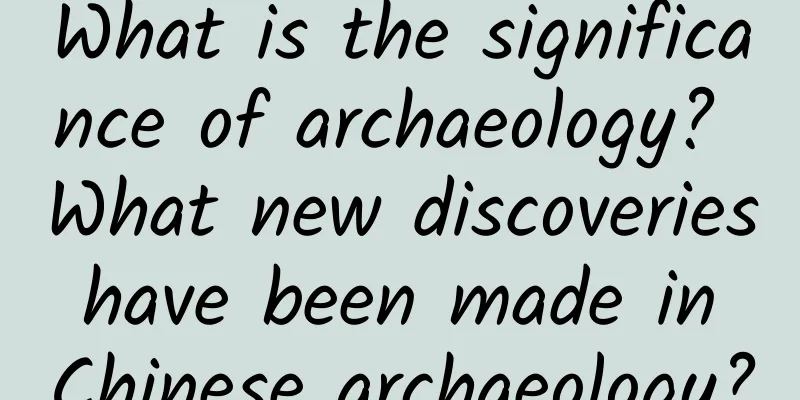What is the significance of archaeology? What new discoveries have been made in Chinese archaeology?

|
As one of the ancient civilizations in the world, Chinese scholars have long noticed the importance of conducting investigations and research on ancient relics. Archaeology is to clarify the development of the entire Chinese civilization behind these sites and cultural relics. This is the greatest interpretation, restoration and inheritance of Chinese culture. In 2020, many ancient sites were discovered in my country. Now, let's learn about the relevant information with Encyclopedia Knowledge Network! Contents of this article
What new discoveries have been made in Chinese archaeology?On March 26, the "New Archaeological Discoveries in China in 2020" were announced: 1. Neolithic Site of Jingtoushan, Yuyao City, Zhejiang Province The cultural deposits of the site generally slope from west to east along the slope of the underground hillock, with a thickness of more than 2 meters and divided into 12 small layers. The excavation unearthed settlement remains such as open-air fire pits, food storage pits, and living utensils processing and production areas. The unearthed relics can be divided into two categories according to their nature: a large number of animal, plant and mineral remains abandoned after artificial use; artificial artifacts such as pottery, stone, bone, shell, wood, and woven fabrics. The most abundant animal remains are marine shells, including five major categories: cockles, oysters, conches, clams, and razor clams, followed by various fisherman and hunter animal skeletons. Experts believe that the excavation of the Jingtoushan site has great academic value. This site is the first shell mound site discovered in Zhejiang Province and the Yangtze River Delta region. It is also the deepest and earliest typical coastal shell mound site found on the coast of China (8300-7800 years ago). Archaeological excavations have shown that Yuyao, Ningbo and even the coastal areas of Zhejiang are the key areas where China's maritime culture originated. 2. Shuanghuaishu Neolithic Site in Gongyi City, Henan Province The Shuanghuaishu site is located on the southern terrace of Shuanghuaishu Village on the south bank of the confluence of the Yiluo River and the Yellow River in Gongyi City, Henan Province. After years of archaeological investigation, exploration and excavation, it is confirmed that the existing area of the site is about 1.17 million square meters. The settlement structure layout is basically clear, and large sacrificial pits, storage pits, pottery kilns, house sites and other cultural relics have been discovered, with abundant unearthed relics. After preliminary research, the cultural relics of the site can be divided into five phases and seven sections. The first phase is the Peiligang culture period; the second phase is equivalent to the late stage of Dahe Village Phase II; the third phase is equivalent to Dahe Village Phase III; the fourth phase is equivalent to Dahe Village Phase IV, which can be divided into three sections; the fifth phase is equivalent to Dahe Village Phase V. According to reports, the Shuanghuaishu site is a carefully selected capital settlement site dating back about 5,300 years. It is surrounded by Hulao Pass in the east, Heishi Pass in the west, Songshan Mountain in the south, and the Yellow River in the north. Surrounding it are many settlements such as Qingtai, Wanggou, Xishan, Suyang, Tumen, and Zhuoli, forming a large-scale settlement complex. 3. Guoyuanzui Shang and Zhou Dynasty Site, Wuhan, Hubei The Guoyuanzui site is located on a terrace at the northern foot of Mount Lutai and on the eastern bank of the Luoshui River. The site is mainly composed of cultural relics from the Shang Dynasty to the Spring and Autumn Period. With the approval of the State Administration of Cultural Heritage, continuous excavations were carried out in the northwest of the Guoyuanzui site from May 2019 to November 2020, with an excavation area of about 1,120 square meters. The site accumulation can be roughly divided into three periods. The first period is from the Huayuanzhuang period to the first period of Yinxu. The main discoveries were bronze casting relics. A total of 1 Shang Dynasty platform, 9 furnace bases, 1 house site, 71 ash pits, 5 burnt earth relics, 8 ash ditches, and 18 pit-shaped relics were uncovered. The second period revealed 1 burnt earth relic from the late Shang Dynasty and early Zhou Dynasty. In the third period, 5 tombs from the Western Zhou Dynasty to the Spring and Autumn Period were excavated. 4. Yaoheyuan Western Zhou Dynasty Site in Pengyang County, Ningxia The Yaoheyuan site is located in the northern part of Yaohe Village, Xinji Township, Pengyang County, Guyuan City, Ningxia Hui Autonomous Region. It is located on a triangular plateau where the Li'er River, a tributary of the north side of the Red River in the upper reaches of the Jingshui River basin, and the Xiaohe River, a middle tributary, and the Dahe River meet. Since the site was discovered in May 2017, archaeological exploration and excavation work has been carried out continuously, confirming that the site covers an area of about 860,000 square meters, about 1,000 meters long from east to west and more than 800 meters wide from north to south. The L-shaped trench and the north-south wall divide the Yaoheyuan site into two parts: the inner city and the outer city. It is reported that the Yaoheyuan site has a dense water network and crisscrossing ditches. Exploration has discovered a large number of large water storage pools with main canals connected to these pools. They are closely related to bronze casting workshops, pottery workshops, etc., indicating that the people at the site attached great importance to the development and utilization of water resources. 5. Kayakkuduk Tang Dynasty Beacon Tower in Yuli County, Xinjiang The Keyakkuduk Beacon Tower Site is located in the desert area of Yuli County, Bayingolin Mongol Autonomous Prefecture, Xinjiang. It is a beacon tower in the Peacock River Beacon Tower Group, a national key cultural relic protection unit. The Keyakkuduk Beacon Tower Site was built on a large red willow sand pile. It is a military facility site consisting of the beacon tower itself, residential houses and other buildings. So far, one house, one wooden fence, one step and five ash piles have been cleared. According to reports, the relics unearthed from the ash pile are rich in variety, covering all aspects of daily work and life. As of October 31, 2020, more than 1,220 pieces (sets) of various relics have been unearthed, including more than 780 pieces (sets) of precious paper documents and wooden slips. This batch of wooden slips and paper documents is the largest batch of Tang Dynasty Chinese documents unearthed in Xinjiang archaeological excavations in recent years. 6. Six major sites of the 2018 Xuewei No. 1 Tomb of the Reshui Tomb Group in Dulan County, Qinghai Province were selected The Reshui Tombs are located in Reshui Township, Dulan County, Haixi Mongol and Tibetan Autonomous Prefecture, Qinghai Province. They were discovered and named in 1982 by archaeologists. In 2018, the theft of the Reshui tombs shocked the whole country, involving 646 cultural relics. In the same year, with the approval of the State Administration of Cultural Heritage, a joint archaeological team consisting of the Institute of Archaeology of the Chinese Academy of Social Sciences and the Qinghai Provincial Institute of Cultural Relics and Archaeology began to conduct archaeological excavations on the stolen tombs, which were numbered "2018 Xuewei Tomb No. 1". During the excavation process, archaeologists actively carried out multidisciplinary cooperation, using technical means such as total stations and drones, as well as detection and identification methods such as tree rings, 3D modeling, animal and plant archaeology, DNA, and metallographic analysis to comprehensively, comprehensively, and accurately record and extract relevant information. What is the significance of archaeology?If you wake up in the morning and find that you have lost your memory, you don’t know who you are, where you came from, or where you are going, and you can’t remember anything you did yesterday or the day before yesterday, how would you feel? What if a country or an ethnic group loses its memory? Everyone, no matter how indifferent he is to the past, is more or less interested in what his ancestors did and what they thought, but these fleeting thoughts are not deep or unified. The oldest human fossils discovered in my country are more than 2 million years old. my country's written history dates back only 3,000 years. So how do we restore the past of our ancestors from more than 2 million years ago to the time when the oracle bones of Yinxu appeared? Only archaeology. In the past, archaeology also played an important and irreplaceable role. Archaeology used handed-down documents to restore the past. Handed-down documents have their own limitations, while archaeology used unearthed objects to restore the past, speaking for the dead and bringing the dead back to life. Past studies and archaeology are the two wheels of the cart and the two wings of the bird of broad history. They provide us with information about the survival of our ancestors and enrich our nation's memories of the past. If people want to look forward and face the future, in addition to taking one solid step at a time, they must also look back at the road they have come. What historical events have been proven by archaeology?Everyone knows that Japanese people prefer to wear wooden clogs, which can be said to be a must-have item for Japanese people at home. The Japanese have always insisted that this was invented by their ancestors. In fact, wooden clogs were invented by the Chinese. There are records in ancient Chinese books, but there is no physical evidence. In 1984, a pair of wooden clogs dating back more than 1,700 years were unearthed from the tomb of Zhu Ran, a general of the Eastern Wu during the Three Kingdoms period, in Ma'anshan. This artifact directly proved that wooden clogs were designed and created by the Chinese. At the end of the Qing Dynasty, Emperor Guangxu died suddenly in his thirties. There were several theories about the cause of his death. Some said he died of illness, some said he was poisoned. In short, it was very strange. Later, archaeological evidence confirmed that he was indeed poisoned, or arsenic poisoning. |
<<: What is the material of ice silk mat? How to clean and maintain ice silk mat
>>: What is the difference between green tea and black tea? Which is healthier?
Recommend
Leg shaking, nail biting... How to stop these obsessive-compulsive disorders?
Leviathan Press: I remember a primary school clas...
What causes numbness in hands during early pregnancy?
When a woman finds out that she is pregnant, it i...
What to do if you have insomnia all night during menopause
Insomnia all night during menopause is caused by ...
How long does it take to drain the blood after a miscarriage?
Whether after miscarriage or natural delivery, wo...
How long does it take for a woman to detect early pregnancy?
In fact, if a woman is confirmed to be pregnant 7...
The infection symptoms after leep surgery are so serious
Many women have to undergo LEEP knife surgery for...
I got pregnant with 8 girls in a row?
With the development of society, the idea of fa...
Can breast massage improve breast hyperplasia?
Breast hyperplasia is no longer a rare disease in...
Is septate uterine pregnancy possible?
The uterus is the main place for women to become ...
What does vaginal discharge look like when you are pregnant?
Pregnancy is a topic that most young couples cann...
"Sitting with legs apart is the healthiest sitting posture"? Orthopedic experts remind...
"Sitting with legs apart" is an indecen...
Girls' physical development
Parents should be aware of their children's g...
How to solve vulvar itching with white herpes?
People often feel vulva itching. At this time, yo...









